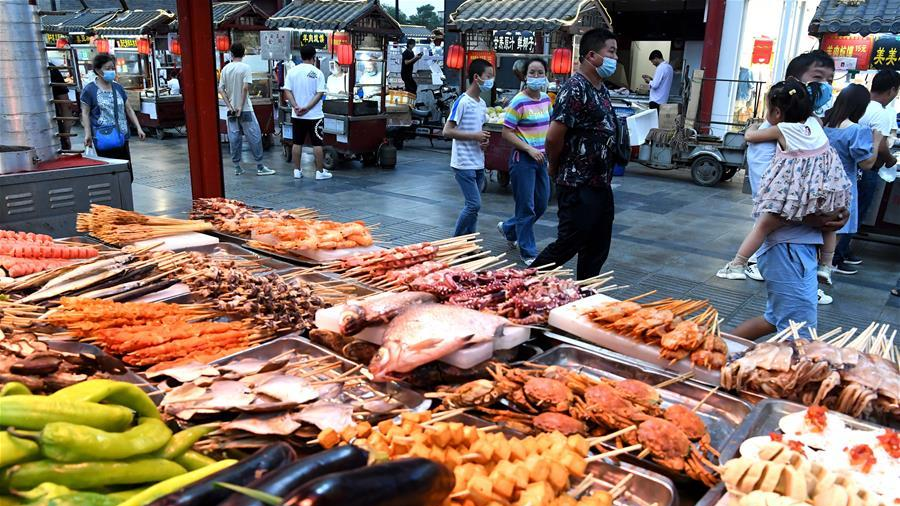
People pass by a barbecue stall in the night market of Drum Tower in Kaifeng, central China's Henan Province, June 2, 2020. /Xinhua
People pass by a barbecue stall in the night market of Drum Tower in Kaifeng, central China's Henan Province, June 2, 2020. /Xinhua
Editor's note: Freddie Reidy is a freelance writer based in London. He studied history and history of art at the University of Kent, Canterbury, specializing in Russian history and international politics. The article reflects the author's opinions, and not necessarily the views of CGTN.
Potential economic hardship normally brings about a culture of thrift, and so, China has responded to a dip in employment levels with the stimulation of the "market economy," and no, this isn't the Shanghai Stock Exchange but traditional markets in villages, towns, and cities across China. What place does the market stall have in the 21st century, though, and can move to support markets really stimulate the economy?
For many, markets embody a romantic image of picturesque, al fresco emporiums of the finest produce. Whether it be the famous flower markets of Paris' Rungis or Covent Garden in London or the fish markets of Billingsgate or Tsukiji in Tokyo. These famed markets though, are more than tourist destinations and are founded on the quality and freshness of their produce but also their convenience and negotiable prices.
It is therefore natural as the Chinese economy begins to resurface from the mire of COVID-19, the government should look to the market once again to kick start the nation's economy. Indeed, traditional markets are a rich source of employment. Chinese Premier Li Keqiang recently praised the city of Chengdu for generating 100,000 jobs through the opening of 36,000 stalls within the city.
The praise of the premier was echoed by the deputy director of the Beijing Economic Operation Association, Tian Yun, who stated that morning and night markets could generate about 100 million jobs, telling Global Times that "Last year, one point of GDP growth was estimated to have generated about 2 million jobs. Assuming that there are 5 to 6 million new street stalls this year, it can be equivalent to 2-3 points of GDP growth".
There is also a great cultural significance which traditional markets hold. Today's economy may be driven by efficiencies and convenience, but a market offers direct contact with vendors and producers and an ability to scrutinize produce and negotiate price, which isn't available online or in a shop.
Prospective buyers are also able to shop more seasonally for raw ingredients, sourcing potentially overlooked items. Markets also offer an intangible link to place, affording the preservation of many smaller local traditions and delicacies which struggle for a market position within a modern retail environment.
A growing trend towards local and sustainable sourcing can also be fostered as buyers re-establish a connection with the food of their parents and grandparents. Such moves help preserve cultural traditions in the face of encroaching Western convenience food.

People visit a toy booth at a night market near Hainan University in Haikou, south China's Hainan Province, June 1, 2020. /Xinhua
People visit a toy booth at a night market near Hainan University in Haikou, south China's Hainan Province, June 1, 2020. /Xinhua
Such a move by the government is timely, as many markets struggle within an increasingly digitized age. There have also been concerns over hygiene standards, congestion on streets, and pollution, among other considerations.
China is not alone in facing these obstacles, however. Billingsgate fish market in London moved from its home in the City of London to London's Docklands financial district, and Tokyo's Tsukiji moved to a new site Toyosu, Koto. In Singapore, traditional hawkers trade in designated hawker centers.
Responding to modern standards and demands is therefore important, but maintaining the character, authenticity, and quality is the key to future success. Modern markets in China can now rely on technology such as WeChat Pay to reduce reliance on cash, leading to greater transparency and reduced petty crime in market areas.
The relaxation of market regulations advocated by members of China's National People's Congress is also driven by the knowledge that local markets can respond to local demands rapidly, with minimal capital expenditure, leading to a swift and sustainable revitalization of the economy.
There is a great potential to continue the renaissance of the "market" economy. To do so, it requires markets to offer goods and services in a way online, and mass retailers cannot, responding to local needs and bringing expert knowledge.
Embracing technology, especially concerning payment, allows for far greater transparency and financial regulation, reducing the risk of corruption.
For the environment too, the market offers retail without the need for excess stock, reducing waste while promoting locally sourced produce that reduces "food miles".
The renaissance of the market stalls, whether day or night, therefore, offers a unique opportunity to create jobs, safeguard China's cultural heritage and reconnect much of the urban population with the producers of their food while simultaneously stimulating the national economy.
(If you want to contribute and have specific expertise, please contact us at opinions@cgtn.com)